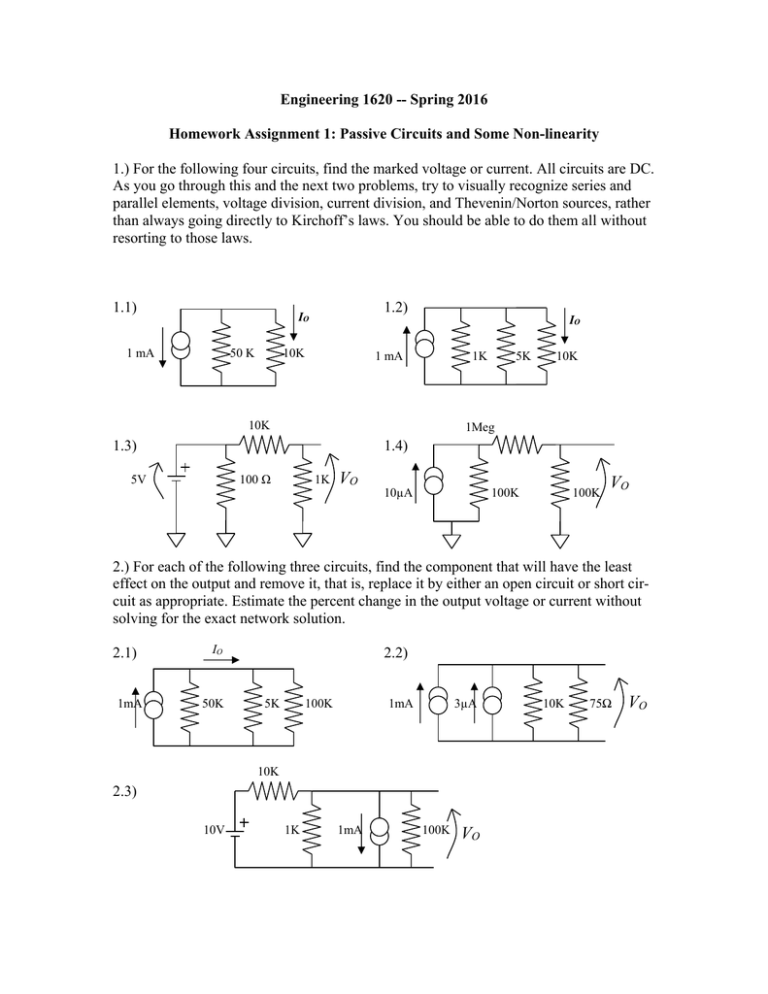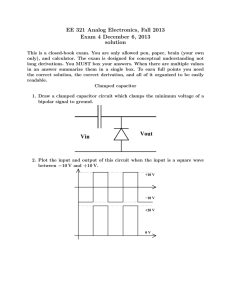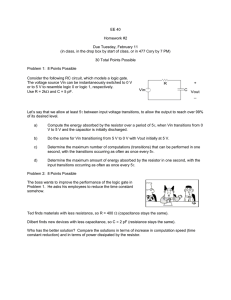VO VO VO - Brown University
advertisement

Engineering 1620 -- Spring 2016 Homework Assignment 1: Passive Circuits and Some Non-linearity 1.) For the following four circuits, find the marked voltage or current. All circuits are DC. As you go through this and the next two problems, try to visually recognize series and parallel elements, voltage division, current division, and Thevenin/Norton sources, rather than always going directly to Kirchoff’s laws. You should be able to do them all without resorting to those laws. 1.1) 1.2) IO 1 mA 50 K IO 10K 1 mA 1K 10K 5K 10K 1Meg 1.3) 1.4) 5V 100 Ω 1K VO 10µA 100K 100K VO 2.) For each of the following three circuits, find the component that will have the least effect on the output and remove it, that is, replace it by either an open circuit or short circuit as appropriate. Estimate the percent change in the output voltage or current without solving for the exact network solution. 2.1) 1mA 2.2) IO 50K 5K 100K 1mA 3µA 10K 2.3) 10V 1K 1mA 100K VO 10K 75Ω VO Engineering 1620 – Homework 1 Spring 2016 3.) For each of these three circuits sketch the gain, that is, the magnitude of H s , marking flat gain regions, corner frequencies and slopes of asymptotes. You should be able to do this by Thevenin-Norton transforms, combining components and even approximating when the error is under 2 %. 3.1) 100Ω 10µF 10K vin 100nF vout 3.2) Note: the box encloses a voltage controlled current source. The siemens is the unit of conductivity. In English the same word is both singular and plural. Multiplying a voltage by some number os seimens results in a current in amperes. 1mS* vg vout vin 100K vg 2K 100pF 20K 100pF 3.3) 10mS* vg vout vin vg 1K 4.) Right outside my office is a former secretarial bay that used to be equipped with a refrigerator, microwave oven, and coffee maker so the graduate students could prepare lunch or midnight snacks. (They notice the leg irons less if allowed to feed regularly.) One of the pleasures of the place was to return to my office to the smell of hot Chinese food. ABET wishes us to include some economics in our courses, so here is my effort at letting you think about the probable utility operations that feed the grad students. A significant part of Rhode Island’s electricity is imported from the hydroelectric plants of northern Quebec near James Bay about 1500 km away. It travels over 750 KV hightension lines to northern Rhode Island whence it is distributed to the Franklin Square sub2 Engineering 1620 – Homework 1 Spring 2016 station in Providence near the Point Street bridge and on to Brown. While it is impossible to separate the power flow into the system from multiple sources – including from the Manchester Street power plant itself – let us suppose that some lunchtime when the microwave oven (600 watts) is turned on, it is serviced entirely from Canada. In effect Brown rents a part of that long transmission line for the cooking time. 4.1) Power distribution companies try to hold transmission losses overall to less than 6 %. Allowing for a third of that loss along the main line (750 KV) from Canada to Burrillville, how large is the cross sectional area of the wire Brown rents? (To be more precise, the 750 KV connection only goes as far as Albany, NY and a 345 KV link runs on to Burrillville but let’s keep this simple.) The part of the wire used by the toaster is a small enough fraction of the whole wire, that we can assume its cross section is square. What is the edge size? (For reasons of weight and cost, that line is probably aluminum with a resistivity of 2.8 micro-ohm cm.) 4.2) The spot metal price of aluminum on the NY market last night was $ 1.526 per pound. Assuming that the material cost is only one quarter of the cost of the line, what capital investment does just that line have? (After all, the line required towers, support cable, insulators, construction, etc. Moreover each wire has a steel cable core to provide sufficient strength and yield resistance to hang in long sections.) A return on capital investment rate of 15 % over a year of continuous use to cover maintenance, overhead, idle time, and profit might be reasonable. How much must Brown pay for this rental in the five minutes it takes to nuke a pack of Green Giant Chinese veggies? On average, a kilowatt hour costs around $ 0.12 for the University. How much did the veggies cost the University and what fraction of that went for the transmission line? 4.3) A compromise between thermal management and electrical insulation limits generators to about 20 KV output. Power enters Prince Lab for the whole campus on a 12,000 volt line under the parking lot to Hope St. No 750 (or 345) KV line comes into Franklin Square. What is the minimum number of transformers required in the system and what are their turns ratios? (If one voltage along the way is unknown, call it X and compute turns ratios symbolically.) 4.4) Make a block diagram of the system, showing transformer placement, turns ratios, voltages, etc. 5.) Find the transfer function, Thevenin equivalent circuit and Norton equivalent circuit for this two-capacitor circuit. What is its amplitude response at DC and as frequency goes to infinity. Are either of these results a surprise? C1 vin C2 3 vout Engineering 1620 – Homework 1 Spring 2016 6.) Inductors are common again! Not very long ago, say the last decade of the 20th century, inductors were relatively rare in electronic systems. The large inductors of radios and audio systems prior to 1980 were pretty much gone and new uses had not arrived. The typical catalog of electronic parts, from a distributor like Digikey or Newark Electronics, would only have a handful of pages for coils of all types. Now they have thousands of inductors from a dozen or so companies. This reflects their use in very high frequency communications (1.5 GHz and up) and in switching power supply circuits. I recently needed to design a few hundred megahertz filter and the circuit shown here was one that came as an intermediate form of what I wanted to make. (One designs such filters in a series of mapping steps. My ultimate design was a bandpass filter for a simple low-power wireless receiver with a data bandwidth of 40 MHz.) Find the transfer function of this circuit in algebraic terms, that is, in terms of the variables L, C and R. Push K . What kind of a filter is it? What is the your answer into the form H s 2 as bs 1 amplitude of response at DC? At what frequency is its phase shift exactly 90 degrees? What is the amplitude response at that frequency? This particular filter is monotonic. Sketch its amplitude response as a Bode plot clearly enough to show the low and high frequency asymptotes and where they intersect. All frequencies should be numbers expressed in Hertz, NOT rad/sec. R = 50 ohms vin L=141 nH R= 50 ohms C=56.3 pF vout 7.) I have already alluded several times to the fact that transistor circuits are not linear and that this can be a problem in designing linear amplifier. In your third lab, you will use a MOSFET transistor to build an amplifier to drive the speaker for music. We will examine MOSFETs more toward the middle of the course but for the purpose of this problem all you need to know is that some of them have a current-voltage relation that is quadratic. Analogous to the vacuum tube grid to filament voltage controlling the plate current, the "drain" current of a MOSFET may be proportional to the square of the "gate" to "source" voltage. In the circuit below, the device labeled M1 is the MOSFET transistor. If the potential 2 vDS 0 , then the drain current is roughly iD K N vGS where KN is a constant. The "gate" terminal is the one connected to the common node of RG and C. The gate draws no AC or DC current. Suppose further that VGG = 0.7 volts, KN = 500 A/volt2, RG = 22K and C = 0.68 fd. 4 Engineering 1620 – Homework 1 Spring 2016 7.1) What kind of filter is the linear part of this circuit for the signal vin to vGS? What is its cutoff frequency? 7.2) Suppose vin 0.25 sin 1t sin 2t where f1 1 KHz and f 2 1.5 KHz. (This would be a simple test of intermodulation distortion.) Write an expression for vGS, the voltage on the gate. You may use a simple approximation if you tell be what it is. Use numeric coefficients. 7.3) The output of the circuit is the current iD. Because the non-linearity of the MOSFET is a simple function, it is possible to write the output as a sum of simple sinusoids. Find an expression for the current expressed that way. 7.4) What are the peak currents of the linear part of the output, that is, the terms with the same frequencies as the original input signal vin? 7.5) What are the peak currents and frequencies of all the output terms that are not in the original signal? What percent of the 1 KHz output term is the amplitude term at 2 KHz? (This is called the second harmonic distortion and a good amplifier has less than 0.5 %.) If you used the output current to drive a speaker, would this be a good amplifier for a music signal applied at vin? iD RG C M1 vGG vin vGS 5 vDS



